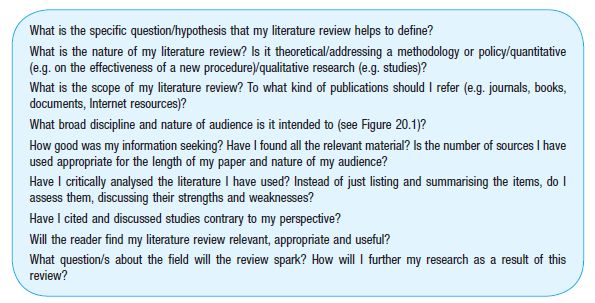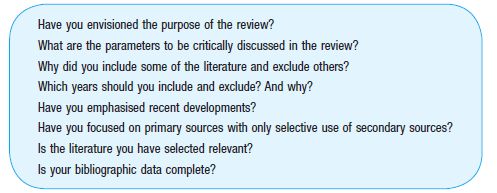Figure 20.1. Factors involved in designing literature review. The outline of any literature review is a direct product of nature of audience and the novelty factor of the contents, which accordingly reflects its broad objectives (creating awareness, educational or scientific advancement). The degree of novelty factor is directly proportional to the commercial value/economic implications.
Furthermore, conducting a methodical literature reviewing process has the following benefits:
The overall objectives of writing a literature review could be (i) to create awareness among the scientific/non-scientific community, (ii) to educate students and (iii) to communicate scientific advancement/scope for advancement to the scientific community (Figure 20.1).
Before attempting to write a literature review, critically refer to a wide range of published reviews in your subject area to understand the style and flow adopted. Cling to the style of the field and adopt the best practices from diverse sources. Avoid limiting your writing to plain texts and summaries, rather take the form of a critical discussion, demonstrating insight and an awareness of differing arguments, theories, approaches and methodologies. It should be a slicing and dicing of the relevant published literature, linked at all times to your own purpose and rationale. Wherever possible, appropriately summarise the data using tables or figures and consider providing key points in boxes. Focus on the points from the article, which are repeatedly cited in other articles and are critical to the field of your research. It is helpful to begin by outlining key points and then building paragraphs to express those points. From the grammatical point of view, it is important to use nouns instead of pronouns (e.g. they, it, this).3,5 While reviewing the literature, it is not just essential to grasp the final conclusions of the work but it is also important to critically evaluate the methodologies adopted and steps that lead to the conclusions made in any study.4 One should make their thoughts visible to the readers. Compare and contrast different author’s views on an issue and group authors who drew similar conclusions. Note areas in which authors were in disagreement, highlight landmark studies highlight gaps/opportunities in research. Show how your study relates to published studies, the literature in general and finally conclude by summarising what the literature reveals and what are your views on it. A good literature review, therefore, is critical of what has already been written, identifies areas of controversy, raises questions and identifies areas which need further research.1,5 The questions you should pose to yourself before starting to write a literature review are presented in Figure 20.2.
How to Do Literature Search
As this topic will be dealt with in detail in the next chapter, I will briefly brush on a few critical points. Before attempting to do a literature search you need to define the topic of your work and pose the following questions to yourself: What is the purpose? What does it mean? What are the key words? Are there other words that could be used (such as synonyms, variations in spelling)? What do you already know about the topic? What is the scope? Do you need everything ever written on this topic, or just that which has been published in the last couple of years? Before starting a search for information, it is important to develop a search strategy that will most effectively locate useful, relevant information (Figure 20.3). This will often involve breaking down research questions or objectives into keywords or phrases; entering your search; and evaluating your results to determine whether you need to employ various strategies to broaden, narrow or otherwise modify your research.4,6 It might be useful to include alternative ways of phrasing and expressing concepts and ideas. Think about both general terms and very specific terms for broadening and narrowing your search, respectively. The keyword or phrase is the basic unit of any search. You may find it helpful to consult subject dictionaries and encyclopedias, or a textbook glossary for the common terminology of the subject area.4 The use of an index and/or thesaurus is also advisable to establish the useful terms. After identifying the keywords, you need to identify resource for literature search. Information is available in a number of formats. It is important that you understand the significance of various formats and know what will best suit your information requirements, that is, books, reference materials, journals, conference papers, dissertations and internet.
Appropriately Citing the Literature: Critical Analysis and Judgement
With the increase in the number of scientific journals/content published over the years, it is intriguing and common to find conflicting/diverse data on any topic in the literature. Hence it is important to develop skills to critically analyse and judge the published literature (Figure 20.4). One of the ways to adopt to judge any publication is by looking into the methodology the authors have used to answer the questions posed in their hypothesis. Were the methods adopted specific and selective? Was there any possibility of false positive/negative outcomes? It is important that you remain objective and unbiased while critically examining the data; keep an open and honest view.4 Check if the authors have appropriately and clearly formulated a hypothesis? Is the significance (scope, severity, relevance) clearly established? Are there alternate and better approaches to address the hypothesis? Is the data analysis appropriate? Envisage the author’s research orientation (is it speculative, interpretive, innovative, or a combination of these?). Has the author evaluated the literature relevant to the hypothesis, taking into account even the conflicting and confounding opinions? Is the analysis of the data accurate and relevant to the research question? Are the conclusions validly based upon the data and analysis? Is there an objective basis to discussing the results, or is the author merely ‘proving’ what he or she already believes? In what ways does the source contribute to your understanding of the question and relate to your hypothesis? What are the strengths and limitations? Once you have honestly answered these questions, you will be in a position to critically judge any source of literature and adopt it for your own literature review.4
Formulating the Literature Review
Identifying the Necessity Based on Background Information
Several ingredients contribute to the recipe for formulating the literature review. The foremost criteriorn in this is to clearly define the aims and objectives of writing the literature review and envision the nature of audience and the scope of research, depending on the degree of novelty or innovation in the question posed (Figure 20.1). The overall structure of the review will largely depend on your research area. What you need to do is to group together and compare and contrast the varying opinions of different writers on certain topics.3–5 What you must not do is just describe what one writer says, and then go on to give a general overview of another writer, and then another and so on. Your structure should be dictated instead by topic areas, controversial issues or by questions to which there are varying approaches and theories. Within each of these sections, you should then discuss what the different literature argues, remembering to link this to your own purpose. Linking words are important. If you are grouping together writers with similar opinions, you would use words or phrases such as similarly, in addition, also, again. More importantly, if there is a disagreement, you need to indicate clearly that you are aware of this by the use of linkers such as however, on the other hand, conversely, nevertheless. At the end of the review, you should include a summary of what the literature implies, which again links to your hypothesis or the main question.
Recipe for Literature Review
Having provided the theoretical background for writing a literature review, I will now focus on the practical aspects of formulating a literature review. You first need to decide what you need to read. If you are at an early stage of research career, most likely you will be given a list of books or directed towards areas of useful published work by your supervisor/guide. Make sure you take this help. A good literature review needs a clear line of argument.4,5 In order to express an unbiased opinion, you need to have written down critical notes and comments while reading the published work. Adopt the following broad outline: Include a clear, short introduction giving an outline and justification of the review. Have a clear association between your arguments and the published work. Include a short summary or use quotations at the end of each section. It is important that you always acknowledge opinions which do not agree with your hypothesis and where/whenever possible, give suitable reasons for your conflicting opinion on the topic. Remember ‘ignorance is not the path to progress, but knowledge is’. In addition to being positive or negative about published data, you will have to critically analyse it, that is, you will have to analyse the limitations of the study with respect to its results, methodologies adopted and the possibilities of any bias arising due to potential conflict of interests, and also identify the gap for improvement/advancement in the field.
The literature review must contain at least the following three basic elements: (i) an introduction or background information, (ii) the body containing the discussion of sources and (iii) conclusions and/or recommendations.5
Stay updated, free articles. Join our Telegram channel

Full access? Get Clinical Tree





